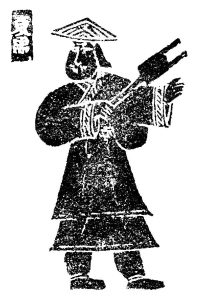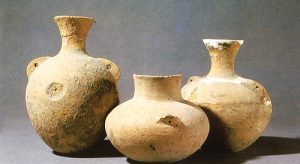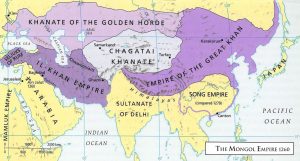Alcohol Agriculture
C. Groom
How has Fermentation and Alcohol Consumption affect the Environment, Economy, and Culture of China?

One of the earliest stories of alcohol in China comes from the third century BCE legends of King Yu. He and the prominent sage in his court, I Ti, had dinner together when I Ti brought his newest invention. He created a primitive kind of alcohol based on cereal grains with wild fruit. After enjoying the first glass together King Yu pondered on the invention and said to I Ti “Among later generations there will be those who will lose their state because of this wine.” He then had I Ti executed to prevent the knowledge of alcohol to spread throughout his kingdom.
This legend came into the Chinese culture at nearly the same time the Shang dynasty ended and the Zhou began. Many of these stories regarding the history of alcohol were used to dissuade popular usage of alcohol, instead reserving it for ritual. Within the Zhou dynasty the idea that alcohol was apart of the downfall of the previous rulers was widespread. Recorded from the Zhou dynasty, one of the ministers said to the ruler, “We know that the Shang lost its Mandate because the feudatories of Shang and Shang’s senior officers and princes became lax through wine drinking.”
Production and Fermentation in Early China.
The earlier history of Alcohol in China we have is from the Henan region of the country, at a archeological site known as Jiahu, where archeologist were able to find traces of alcohol production, tools, and ingredients using naturally fermenting fruit starters in liquid saccharified cereal grains.

This area was the center of China’s first dynasty, connecting the beginning of civilization with the production of alcohol. In other regions of China, there are legends of “Wild Monkey Wine”. This is where wild animals, namely monkeys collect naturally fermenting fruits and collect them together. The people of local villages will go and collect these and use them as fermentation starters to create grain alcohol.
This fruit fermentation is similar to how early Chinese made the first alcohol “wines” within the region. Wild fruits that have begun to rot would contain yeasts that fermented the fruits into alcohol. These starters would then be added to saccharified grain sugars and let rest over a number of days as the yeast created primitive alcohol.
Li and Ch’ang Fermentation
As the Chinese culture grew, the fermenting process became standardized into two different recorded forms that used the natural environment. These fully grain based wines were Li and Ch’ang.
To create Li wines one would germinate available grains. The cooking process allows the saccharification where steamed rice would be added with water. Sung Dynasty author Chu Kung recorded this recipe. Yet the strategy for germinated grains with yeasts for alcohol production was lost in Mainland China before the Ming Dynasty. Japan had continued the use of this recipe and through Japanese sources we can tell Chinese Li wine was germinated through chewing the grain in ones mouth to give the yeasts and enzymes in our saliva into the finished product.
Ch’ang wine was widely used and varied from place to place-based on available plants. Grasses or barks were combined with steamed rice to ferment. It is possible that the origins of Ch’ang wine in Mainland China came from Taiwan as aboriginal tribes still practice this method of fermentation. The surroundings of different cultures shows that environment plays a role in alcohol production.
The North-South Alcohol Split

After centuries of globalization brought new ways to create alcohol to china, a change started to occur between the North and South in how they created their drinks and what they drank.
Tang Expansion of Grape Wine
The Tang emperors brought knowledge of fully grape based wine to China, which became popular in the north of the country. Taiyuan in Shanxi was known as the homeland of wine and grapes in China. The Tang emperors Gaozu and Taizong grew grapes around their palace to go into wine production. This change is also seen in the landscape in the north as huge tracts of land were converted into vineyards for grapes. The conquest of the Mongols and the Southern Song dynasty only hastened the divide between the two regions of the country. Living on the Steppe’s Mongols historically drank alcohol created from their animals, namely fermented milks. Yet with the growth of grape wine they started to become effectuated with the grape drink. They encouraged the development of the wine industry and trade through the Silk Road and with taxes. Wine was taxed at significantly lower rates than any other alcohol. It would come to the country from the Middle East and Europe along the Silk Road trade.
Southern Baijiu

Meanwhile in the South under the Song, with a larger concentration of ethnically Han Chinese in their population, underwent introversion. They turned back to grain fermented drinks, and with the invention of distilling these alcohol, call Baijiu, became cheap and effective for the poorer Southern Song. Trade also played a role in this change, as the Mongol North developed closer trade with Wine Making Europe, while the Song had maritime trade with the Muslim world, where alcohol was in a lower demand. After the Song was conquered, there became a history of sea voyages to secure wine form regions like Bordeaux in France.
The Drunk Khans
The Great Khans that ruled China became further and further infatuated with wine, bringing King Yu’s prediction to light. All but one Khan died between the ages of 28 and 42, and their heavy drinking lifestyle is thought to have played a role. Once the Mongol rule was over thrown with the ethnically Han Ming Dynasty, a reversion of the growth of wine happened. Many vineyards were torn up and replaced with table grape wines. Baijiu continued to become the most widely drank beverage China and today is the most widely drank distilled liquor in the world.
Modern Differences in Production and Drinking.

The growth of Baijiu was only interrupted during the 20th century and the encouragement of beer drinking, namely Tsingtao beer. Here we can study a more marked environmental change for the alcohol industry in China. The growth of the brewery required large amount of grains and hops to be grown within the country, changing large amounts of grassland and forests into grain farms. The industrial excess ruined water supplies, burnt coal, and drained into the local bay. The once pristine mountain water the brewery ran off became polluted as it wove towards the ocean.
Effects and Differences from Cultures Outside China.
Outside of the Chinese alcohol history discussed so far, many different outside groups had ways of production that affected and impacted Chinese fermentation and culture.
The Persians were one of the first cultures to create wine from grapes, and this spread to many Nomadic groups in Central Asia located between the Persian and ancient China. The Sycthians were among these groups that spread a culture of wine throughout Asia. Later descendants of this legendary group, the Sogdians became the early facilitators of trade on the silk road and moved different ornate drinking vessels between Persia and China, these were apart of the drinking vessels found inside of Han tombs. The Uyghurs in the East, although they are a Muslim population widely partook in the creation and enjoyment of wine. Their landscape and environment led to special treatment for many grapes different than the rest of the Far East, in that they put the grape through the process of becoming raisins before making them into wine. Early Mongolian populations of the Steppe were too challenged to grow anything from the scarcity of crops in the region and their nomadic lifestyle. Their adaptation to drinking was to ferment different animal milk into alcoholic drinks.
Conclusion
Alcohol has had an undeniable and profound impact on the culture of China and the world surrounding it. The start of production of fermentation coincided not only with alcohol but the beginning of the Dynastic system. Drunkness caused the collapse of dynasties time and again through the history of China. In a telling story Timur Lenk and his armies, on the eve of the beginning of their planned conquest of the Ming empire in 1405 celebrated with his generals. He drank himself into a stupor and did not survive the night. The army never began the conquest and world history continued to what we know today.
The economics of nations also has impacts onto how and why they make alcohol. The Yuan dynasty taxed wine at a 3.3% rate whereas every other alcoholic beverage was over 25%. The environment of each group had an effect on what they produced, Rice and grain created the yellow wines of the south. The desire for wine by the Yuan dynasty remade the environment of Northern regions by planting vineyards across the region. The North was far more successful in creating wine and the divide between what was drank in the South and North split with dynasties and environments.
